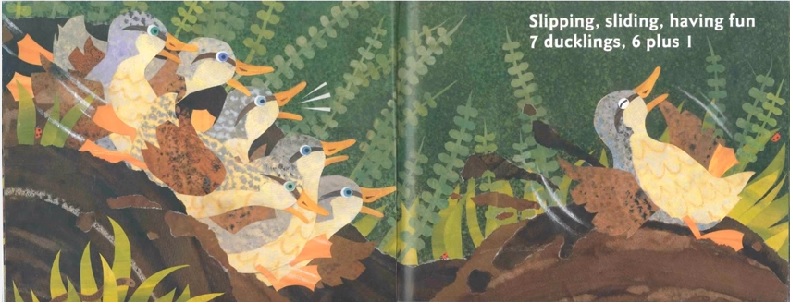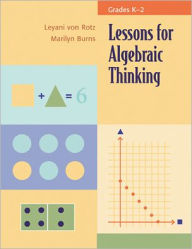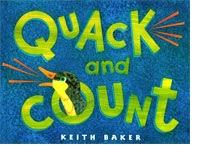A Tweet I read a few days ago led me to a blog post by Nancy Q. Smith titled Equality. In her post, Nancy talks about helping her first graders understand the meaning of the equals sign. The blog reminded me of one of the Starting Points I included in the current fourth edition of About Teaching Mathematics. It’s titled “The Equal Sign: What It Really Means,” and this blog is an excerpt, focusing mostly on the section I included that addresses how I use the children’s book, Quack and Count by Keith Baker, in kindergarten and grade 1.
Students love Quack and Count. They are engaged and captivated by the rhymes and the illustrations of seven ducklings slipping, sliding, leaping, diving, and finally flying away. The first combination introduced in the book is 6 plus 1, shown with six ducklings on the left-hand page and one duckling on the right-hand page. The text reads:
Slipping, sliding, having fun
7 ducklings, 6 plus 1

My typical lesson plan is first to read the book just for students to enjoy. Then I revisit the book and, for each spread, have the students count the ducks on the left, then on the right, and then altogether. For each combination, I write an equation on the board or on chart paper to represent the rhyme and illustration mathematically. For the combination above, for example, I’d typically write 6 + 1 = 7. But after my own experiences and becoming aware of research about the equals sign, I changed that and now write the equation as 7 = 6 + 1.
The first time I taught the lesson with this change gave me a firsthand experience with what the research reported. I was teaching the lesson in a first grade class. After I wrote 7 = 6 + 1, I read the equation aloud. Russell, one of the students, frowned and emphatically shook his head back and forth.
“No,” he said, “you wrote it backwards. It’s supposed to go six plus one equals seven.” It was as if Russell had leapt off the pages of the research articles.
“Yes, that’s another way I could write the equation,” I said and recorded Russell’s suggestion.
Then, for each of the other combinations in the book, I wrote the equations both ways. At the end of the rereading of the book, I had written two columns of equations.
7 = 6 + 1 6 + 1 = 7
7 = 5 + 2 5 + 2 = 7
7 = 4 + 3 4 + 3 = 7
7 = 3 + 4 3 + 4 = 7
7 = 2 + 5 2 + 5 = 7
7 = 1 + 6 1 + 6 = 7
Also, as I read each equation aloud two ways, I alternated using “equals” and “is the same as” for the equal sign, hoping to develop understanding of its correct meaning.
About the Meaning of the Equal Sign
Plus and minus signs are operation symbols, indicating an action to be performed to the numbers at hand. The equal sign, however, is a relational symbol, not an operation symbol. No action is associated with it. Instead, it describes the relationship of equivalence between two expressions, a state of being, not the result of an action.
What often gets in the way of developing relational thinking is that students are used to focusing on computation to get answers, and also to read equations from left to right the way they read sentences. They’ve had much practice with both, so it’s no surprise that they see the equal sign as an indication that they need to write an answer. The suggestion above for using the children’s book Quack and Count is helpful, but it’s not sufficient for helping students broaden their concept the equal sign so that they understand that it’s an indicator of equivalence, not a signal that “the answer comes next.” For additional suggestions for older students, see About Teaching Mathematics (Math Solutions, 2015), Starting Point 7, pages 32–35.

Another Helpful Resource
To build students’ understanding of equivalence and the equal sign, I rely on some of the lessons from Lessons for Algebraic Thinking: Grades K–2 (Math Solutions 2002), a book I coauthored with Leyani von Rotz (Math Solutions, 2002). Chapter 11, “Two Handfuls” is especially useful.



Thanks for the introduction to “Quack and Count” Marilyn. It’s a new one for me so I’ll definitely be adding it to my arsenal.
I appreciate how you presented the 7=6+1 as a starting point because it seemed to immediately draw out the misconception involving the equal sign. When we’ve already identified student misconceptions, why not tackle them head on like you’ve done here? I like this because it screams SMP #3.
Thank you for your posts! I teach 4th grade and can always find something in your posts relevant to my current class. Our current unit has equations (algorithms) where students are solving
a = 15 ~ 3 or 5 = a ~ 3 (~ is division symbol)
My students immediately freak because of the order of the equation along with the letter or symbol. We take a deep breathe and review what makes them uncomfortable and how can they adjust their math minds or the equation. Once they are confident that they have the power to align the equation to fit their math mindset, they can move forward with solving it.
Talking about operations being actions… numbers being nouns… negative signs being adjectives (and not verbs like “subtract”) is often helpful with my adults. “Of usually means multiply…is means equals” has to be carefully built so it doesn’t become a trick, but it helps, too.
This probably too abstract to present to students but it’s probably good for teachers to realize that “=” has distinct uses:
(1) “simplifies to” which could be written “=>” as in 6+1=>7
(2) A *test* (a kind of operation) like “x+1==7” which can be true or false for a given value of x so that you write something like “if x+1=7 then x=7-1”
(3) An assertion as in “7=6+1”
Thanks for these distinctions. I hadn’t thought about “=” in those ways.
I find many great ideas in your posts. Thank you! This one was especially helpful! I teach grade 1 and have always found it difficult to find books to support the concept of partitioning. This is a terrific book to help students experience this concept in context. I have taken to writing my own stories and story problems to help them explore partitioning because I have scoured the internet but found very few. Many thanks!
This is an important concept for teachers as well as students to understand. It seems like a small difference but it really make an impact on student number sense. When working with teachers I urge replacing the equal sign with “the same as”. Another book that I like to use that involves animals balancing on a beam is Equal Shmequel (Kroll 2005). Also includes a mouse and her woodland animal friends who decide to play a friendly game of tug-of-war.
Thanks for the book recommendation. It’s new to me & I look forward to looking at it.
The book “Math Girls” illustrates three uses of equality beautifully:
1) Identity: 7=6+1
2) Equation: x+3=5
3) Definition: Let a=x-3
I credit my initial understanding that students must be exposed to seeing equations as 7 = 6 + 1 and 6 + 1 = 7 from Marci Cook. However, this post really helped me to think more deeply when preparing lessons addressing CCSS 1.0A.7 and 1.OA.8. My instructional plan is to follow the approach for the second reading of Quack and Count. Ultimately, the second read will be a springboard for further discussion with the class goal of defining of the equal sign which we can refer to in future lessons.
Thank you for the enriching background and building blocks for my upcoming lessons! I’m very aware of first time learning and I am a big fan of your work. I’m still carrying an early addition of About Teaching Mathematics. It is well worn!
Thank you so much for this blog post. I am a pre-service teacher attempting to gather as many resources as I can. This is not only a great resources (unfortunately not in print anymore but I’m sure I’ll find it somewhere!) it is also a wonderful reminder about the little knowledge gaps that exist in our classrooms…and in ourselves! I certainly needed a reminder that the equals sign means the same thing in simple equations as it does in more complex ones. I will definitely use “the same as,” in the future.
Welcome to the teaching profession!!! All books in the post are available. Let me know which one you’re having difficulty locating and I’ll send a source.
Thank you for responding, Marilyn! I really appreciate it. I did actually find Quack and Count. My local bookstore didn’t have it and told me it was out of print. I think we were experiencing a miscommunication though. It was definitely on good old amazon 🙂 Grade 1 practicum, here I come!
Hi Marilyn,
I am struggling with the idea of saying “is the same as” in place of the equal sign. If I think of 15 red apples and 8 green apples, it is not the same as 13 red apples and 10 green apples. They are the same total number of apples, but not the same. I would read the associated equation as 15 plus 8 equals (or is equal to) 13 + 10 and reinforce understanding by saying that 15 + 8 has the same value as 13 + 10, not that 15 + 8 is the same as 13 + 10. I’d love to hear your thoughts on this.
Your comment makes sense to me. The difficulty I’ve encountered is when students think of the equals sign as “the answer comes next.” That’s why I think I emphasize the equivalence of the expressions. I understand why “same” isn’t precise. I’ll have to think more about this. Thanks for your comment.